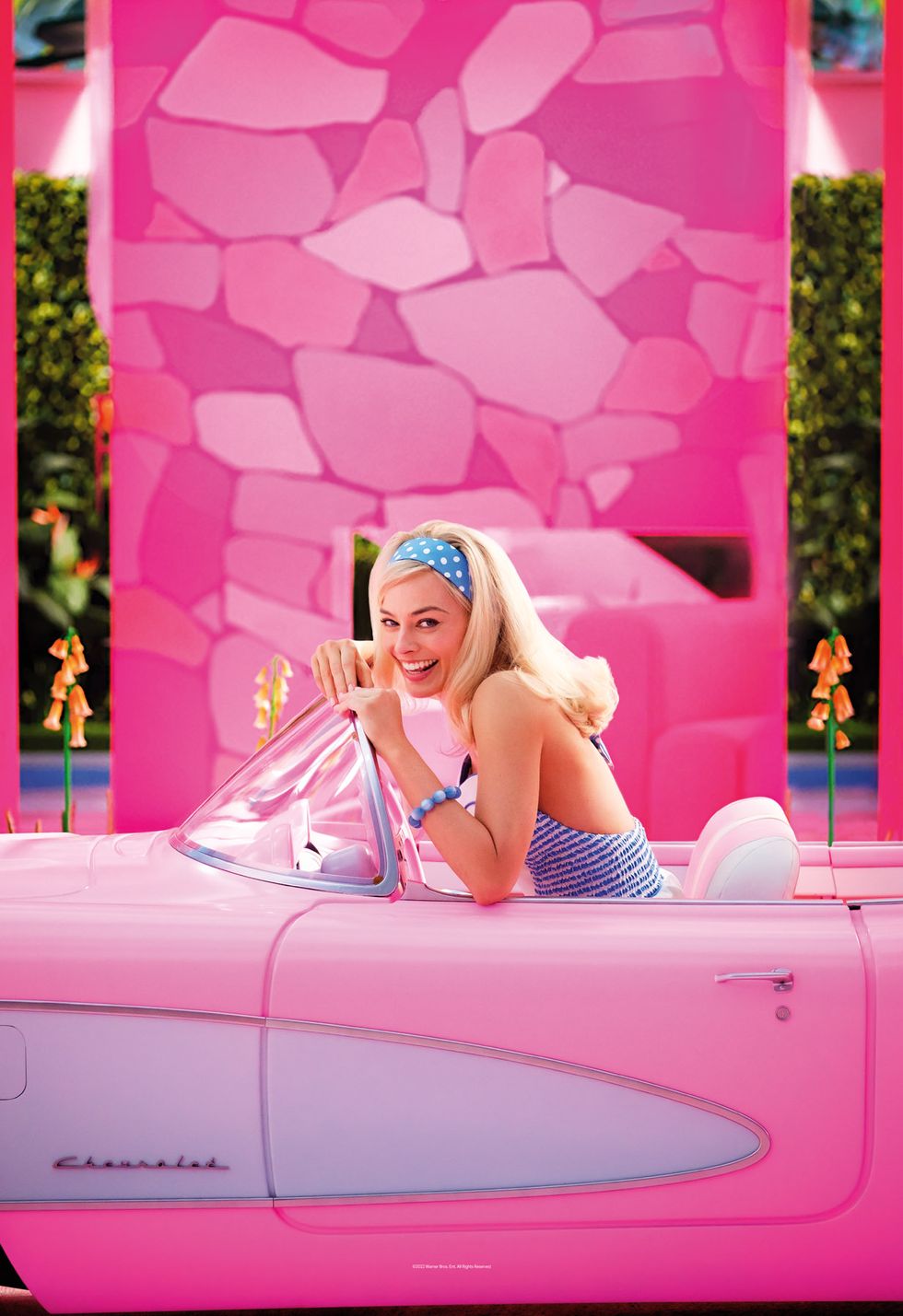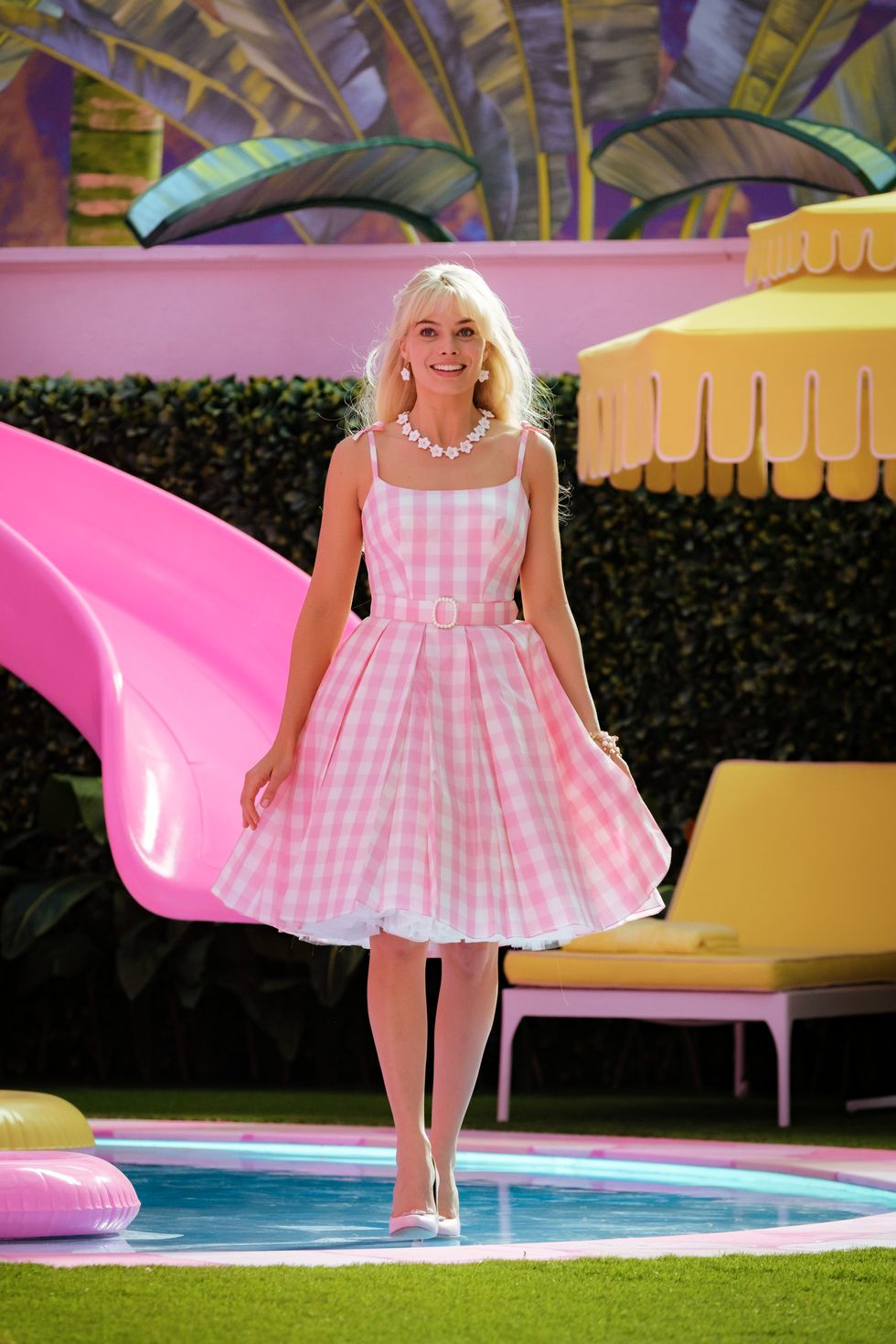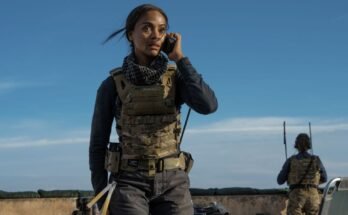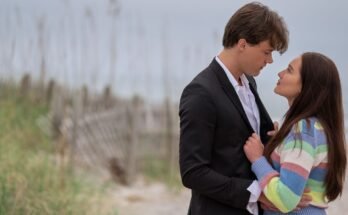In 2023, Barbie is a state of mind.
The new film inspired by the famous doll, directed by Greta Gerwig and starring Margot Robbie, is a two-hour fever dream—funny, sometimes sad, occasionally existential. And at its center is a full-fledged aesthetic universe populated by Barbies and Kens.
Barbie Land on the big screen is irresistibly nostalgic, with the fictional dreamscape serving as a picture-perfect fantasy—or a Pepto Bismol hallucination trip, depending on your perspective. The cotton-candy walls, the pristine archival costuming, and the flawless glam (intricately coiffed hair! perfectly pink pouts!) all work together to make moviegoers believe in the world of Barbie. It’s fun, vibrant, and extremely pink.
Production designer Sarah Greenwood, set decorator Katie Spencer, costume designer Jacqueline Durran, and hair and makeup stylist Ivana Primorac are the four women responsible for imagining Barbie’s universe. Gerwig invited all four to treat her script like a playground for the imagination, giving them free rein to re-create the franchise for cinema-goers. Together in a roundtable discussion for Bazaar.com, they discussed what it took to bring it all to life.
“I remember Greta told us, ‘Go play,’” Greenwood says, adding that the director gave the team no parameters on how to conceptualize the Barbie world—not even from multinational conglomerate Mattel, which owns the doll. But given her history of thousands of looks spanning seven decades, how could anyone possibly capture Barbie in all of her glory in a two-hour film?
“We had to discover the whole thing together—how to make the story, how to make a doll, how to make the world,” Primorac says. “We knew that the world had to be very beautiful, but we had to sort through certain questions, the biggest one being if we should make everything plastic, like the hair, skin, and more. We realized soon enough that it needs to be more than that, and that’s when the real creative process started.”
“We had no idea at the time,” adds Greenwood. “We had to go in there and unravel these layers of what it could be. I remember Greta also told us, ‘Take the audience on a journey a couple of times, and they will then believe it.’”
Below, the Barbie team breaks down what went into the making of the film, from set design to hair and makeup and costumes.
Building the Dreamhouse
There were some standout backdrops in the film. How did you make Barbie’s Dreamhouse appealing in 2023?
Katie Spencer: For Greta, the set had to be appealing. It had to be tactile and, when walking onto the set, it had to spark the same joy you would get if you were opening the perfect toy. We stuck with the midcentury aesthetic and quintessential Americana, which ended up being very appealing.
Sarah Greenwood: For us, it was about capturing the toyness of it, and that was a tricky thing to find. We realized it was all about scale. We bought a Dreamhouse, built it in the office, and played with it, and we suddenly learned more about the peculiar scale. For example, when Barbie puts her hand up, she can touch the ceiling—so the dolls are bigger than the objects around them. That’s why you see Barbie with the giant hairbrush and the toothbrush, with her toy box with Jacqueline’s costumes, and everything like that inside. We even made the lipsticks enormous, because it’s small for the kids that play with them, but for Barbie, it’s huge.
The Weird House was also so intricately made! What did you consider when making a house for Weird Barbie, a doll that’s been played with for too long? What sets it apart from other houses in Barbie Land?
Spencer: It was meant to be like the Boo Radley of Barbie Land.
Greenwood: Exactly. Everything is so askew in the Weird House. She started life as a proper Barbie, but then she got played with too much. The house also started as a proper Dreamhouse and evolved into this chaotic place. In the movie, you see [Weird Barbie] lives with all the other rejected Barbies as well—Mattel’s bad ideas all live in that house, like the Sugar Daddy and the pooping dog. It was incredible that we had Mattel on our side and we were allowed to play with all their rejects, and there were no questions on what we could do.
There’s a clear contrast between Barbie Land and Ken Land—specifically, his “Mojo Dojo Casa House,” as he discovers what the patriarchy is. There were big trucks, horses, and a ton of satire around masculinity. Why was this important for the message, and how did you think to incorporate those components into the design of the set?
Spencer: We knew what was going to happen to the Dreamhouse, because we knew the story. Ken changes just about everything in the house, and for him, the patriarchy basically is horses, mini fridges, and black leather sofas, and that’s what he loves. It was a huge amount of fun to work on, and it was endearing because the Kens aren’t dangerous—they’re foolish and innocent. Everything Barbie had from the breakfast bar and all, we replaced for Ken. Where she would juice her fruit in the morning, they put Doritos in it. Everything was the opposite, and it was a startling change.
Greenwood: There’s this amazing collage by Richard Hamilton where you’ve got the muscle guy and there’s no “real” aesthetic to it whatsoever. We wanted to make his house really ugly and overly aggressive.
Creating Barbie’s signature look
In your words, what is the “Barbie beat”? What did you lean toward in terms of the makeup for the actors?
Ivana Primorac: We tested a lot of different options. At first, we tried a formula that would apply to every doll because, in a way, I thought that a uniform look is maybe what makes them a doll. We quickly realized through the testing period that every doll has to be designed individually and represent the best version of that person. From the finish of the skin to the spot behind the ears, we had to ensure it was neatly done.
There were certain questions of scale, which we all figured out together, because nothing would’ve happened between all of our departments if we didn’t address that first. As far as I was concerned, I had to also play with the hair, for example, which had to be whipped with everyone’s shoulder, and it’s longer than any normal hair.
There’s been a lot of commotion regarding the wigs, especially Dua Lipa’s mermaid wig, since it doesn’t look as natural and seamless as the rest of the cast’s. What made you decide to style the wig in that way?
Primorac: [Dua Lipa’s mermaid character] is the exact copy of the dolls. Those mermaid bodies look exactly like that and with the clunky, multicolored hair. There were many reasons why that happened, and we made those decisions, but we decided to just do a complete copy of the actual Mattel Barbie mermaids.
How did Margot’s makeup reflect her role as the “stereotypical Barbie,” and how was it different from the other Barbies’? What went into it, and how did you achieve it? Did you collab with the actors themselves to create that vision?
Primorac: Margot was the leader of everything, as she was a producer as well. We worked very closely together with her. Once we decided that every Barbie represents the best version of that person, it was very clear that we had to make the skin the nicest version of itself. Sometimes, we would change the makeup depending on the scene, like the ’70s-themed party Barbie throws.
Generally speaking, we went straight back to Jacqueline’s fitting room and discussed every single makeup look in addition to a basic makeup look, which was a perfection of everything for each person but especially her, from the lipstick to the blush color. Viewers may not notice it right away, but each costume had a specially chosen lipstick color. Margot would have more than 50 shades of lipsticks in different shades of pink corresponding with eye shadows and blushes.
Curating Barbie’s closet
The costumes are a huge part of the film. What was the costume creation process like as you were prepping for the film? Did you take inspiration directly from the dolls in the archives, or did you add your own spin to it?
Jacqueline Durran: The most daunting part of the process was the sheer number of costumes that we needed.
First of all, there was the problem of how to approach it and how to make it this thing that could be anything—how to hone it down and make it into a concept that we could understand and work with. We’ve all worked together before, and what’s important is for us to work with the same concept and go in the same direction.
After we did that, it was just the quantity. I remember sitting one day on the sofa where they were going through Margot’s breakdown, and we realized that she changed costume every single time she changed location. It’s unbelievable to imagine how many costumes you’re going to need and how many times she’s going to change. So, I broke down each costume and I had it physically going around the wall of my office, so that I could see it from the first costume—starting with the black-and-white stripe swimsuit, which was the starting point because it was where she was invented—and then make this whole wall go round with over 30 looks to make some sense of it, because there’s the progression in the actual story as it unfolds.
We has a short amount of time to do all of this, because we only had 11 weeks starting from January to March 2022 to prep, and I had no department other than myself.
For Margot’s Barbie, did you find it difficult to style her in a more modern, 2023 way? How do stereotypical Barbie’s outfits compare to those of other Barbies?
Durran: I liked the gingham costume that we see her first in on her perfect day, for lots of reasons. It has the nostalgia of the early ’60s and embodied the perfection of going to the beach during the summertime. That outfit is also based on an original Barbie costume of a pink gingham summer dress. In the film, she has the complete look for a day on the beach: the swimsuit, the hat, and the matching accessories.
Another great example of how we took things and then changed them is the “Hot Skatin’ Barbie” look that she wears when she arrives in L.A. It’s taken completely from the doll, but it’s not the same costume. The original Hot Skatin’ Barbie just has an all-in-one leotard, so we took the fabric and we printed it, and made Margot have a leotard with pink leggings and a jacket for Ryan.
There’s also the parallel unfolding of the history of the Barbie costumes because we started in 1959 with the black-and-white swimsuit, and then touched on different eras. Particularly for the earlier scenes, we wanted to capture the nostalgia while making it appealing to a modern audience, so that it’s not overly labored. I tried to take an original costume and in most instances, I changed it and it doesn’t look exactly like the original doll. It was a reinterpretation, and it’s like taking the idea and the Mattel concept and the thing that everybody remembers, but just making it slightly different for the movie.
Barbiecore is a huge trend right now, but it became an even bigger one in light of the movie. What does Barbiecore mean to you, as someone who quite literally redefined the trend?
Durran: For me, Barbiecore is making a look that is head-to-toe designed for what you’re doing and where you’re going. When you think that you’ve finished the outfit and you’re looking in the mirror, you just add one more thing—because it’s always more than you think it could possibly be—and it’s complete. Oh, and with lots of pop of colors.
This interview has been edited for clarity and length.








